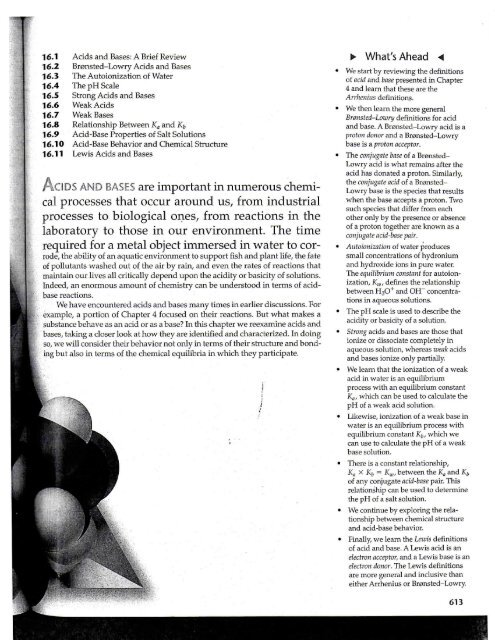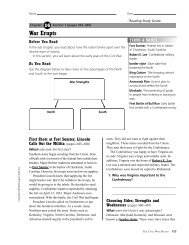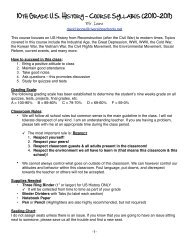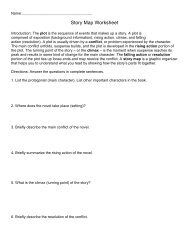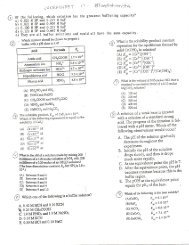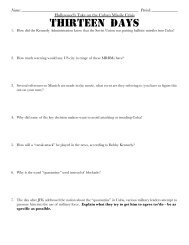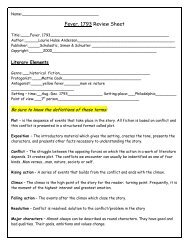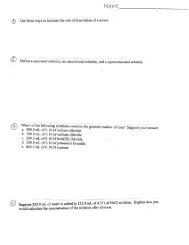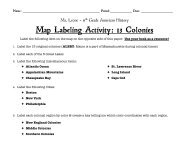Chapter 16 Text
Chapter 16 Text
Chapter 16 Text
Create successful ePaper yourself
Turn your PDF publications into a flip-book with our unique Google optimized e-Paper software.
<strong>16</strong>.1 Acids and Bases: A Brief Review<br />
<strong>16</strong>.2 Br0nsted-Lowry Acids and Bases<br />
<strong>16</strong>.3 The Autoionization of Water<br />
<strong>16</strong>.4 The pH Scale<br />
<strong>16</strong>.5 Strong Acids and Bases<br />
<strong>16</strong>.6 Weak Acids<br />
<strong>16</strong>.7 Weak Bases<br />
<strong>16</strong>.8 Relationship Between Ka and Kb<br />
<strong>16</strong>.9 Acid-Base Properties of Salt Solutions<br />
<strong>16</strong>.10 Acid-Base Behavior and Chemical Structure<br />
<strong>16</strong>.11 Lewis Acids and Bases<br />
ACIDS AND 6AMES are important in numerous chemical<br />
processes that occur around us, from industrial<br />
processes to biological ones, from reactions in the<br />
laboratory to those in our environment. The time<br />
required for a metal object immersed in water to corrode,<br />
the ability of an aquatic environment to support fish and plant life, the fate<br />
of pollutants washed out of the air by rain, and even the rates of reactions that<br />
maintain our lives all critically depend upon the acidity or basicity of solutions.<br />
Indeed, an enormous amount of chemistry can be understood in terms of acidbase<br />
reactions.<br />
We have encountered acids and bases many times in earlier discussions. For<br />
example, a portion of <strong>Chapter</strong> 4 focused on their reactions. But what makes a<br />
substance behave as an acid or as a base? In this chapter we reexamine acids and<br />
bases, taking a closer look at how they are identified and characterized. In doing<br />
so, we will consider their behavior not only in terms of their structure and bonding<br />
but also in terms of the chemical equilibria in which they participate.<br />
» What's Ahead «<br />
We start by reviewing the definitions<br />
of acid and base presented in <strong>Chapter</strong><br />
4 and learn that these are the<br />
Arrhenius definitions.<br />
We then learn the more general<br />
Br0nsted-Lowry definitions for acid<br />
and base. A Br0nsted-Lowry acid is a<br />
proton donor and a Bronsted-Lowry<br />
base is a proton acceptor,<br />
The conjugate base of a Brensted-<br />
Lowry acid is what remains after the<br />
acid has donated a proton. Similarly,<br />
the conjugate acid of a Br0nsted-<br />
Lowry base is the species that results<br />
when the base accepts a proton. Two<br />
such species that differ from each<br />
other only by the presence or absence<br />
of a proton together are known as a<br />
conjugate acid-base pair.<br />
Autoionization of water produces<br />
small concentrations of hydronium<br />
and hydroxide ions in pure water.<br />
The equilibrium constant for autoionization,<br />
Kw, defines the relationship<br />
between H3O+ and OH~ concentrations<br />
in aqueous solutions.<br />
The pH scale is used to describe the<br />
acidity or basicity of a solution.<br />
Strong acids and bases are those that<br />
ionize or dissociate completely in<br />
aqueous solution, whereas weak acids<br />
and bases ionize only partially.<br />
We learn that the ionization of a weak<br />
acid in water is an equilibrium<br />
process with an equilibrium constant<br />
Ka, which can be used to calculate the<br />
pH of a weak acid solution.<br />
Likewise, ionization of a weak base in<br />
water is an equilibrium process with<br />
equilibrium constant K^, which we<br />
can use to calculate the pH of a weak<br />
base solution.<br />
There is a constant relationship,<br />
Ka X Kb - Kw, between the Ka and Kb<br />
of any conjugate acid-base pair. This<br />
relationship can be used to determine<br />
the pH of a salt solution.<br />
We continue by exploring the relationship<br />
between chemical structure<br />
and acid-base behavior.<br />
Finally, we learn the Lewis definitions<br />
of acid and base. A Lewis acid is an<br />
electron acceptor, and a Lewis base is an<br />
electron donor. The Lewis definitions<br />
are more general and inclusive than<br />
either Arrhenius or Br0nsted-Lowry.<br />
613


